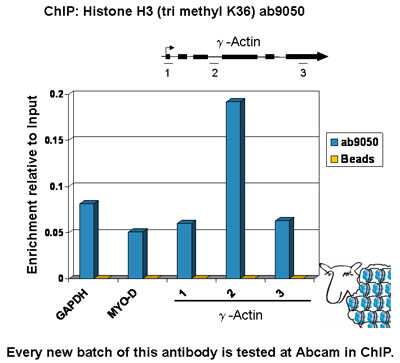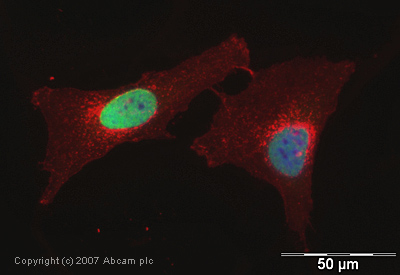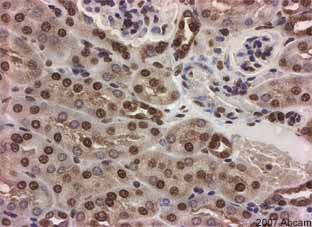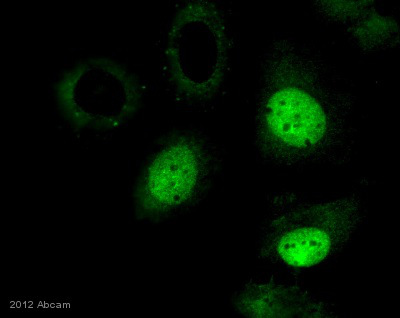Anti-Histone H3 (tri methyl K36) antibody – ChIP Grade (ab9050)抗组蛋白H3抗体
货号:ab9050
厂家:Abcam公司
规格:100ug
保存温度:-20℃ 和 2~8℃
货期:现货2~5天,期货2-3周
咨询: (重庆) (贵阳)
Anti-Histone H3 (tri methyl K36) antibody – ChIP Grade (ab9050)产品信息:
- Product nameAnti-Histone H3 (tri methyl K36) antibody – ChIP GradeSee all Histone H3 primary antibodies …
- Description
Rabbit polyclonal to Histone H3 (tri methyl K36) – ChIP Grade
- SpecificityHistone H3 tri methylated at lysine 36
- Tested applicationsICC/IF, CHIPseq, WB, ChIP, ChIP/Chip, IHC-P more details
- Species reactivity
Reacts with: Mouse, Rat, Cow, Human, Saccharomyces cerevisiae, Xenopus laevis, Arabidopsis thaliana, Caenorhabditis elegans, Fruit fly (Drosophila melanogaster), Schizosaccharomyces pombe, Zebrafish, Rice, Trypanosoma brucei
Predicted to work with: Plants
- Immunogen
Synthetic peptide conjugated to KLH derived from within residues 1 – 100 of Human Histone H3, tri methylated at K36.
Read Abcam's proprietary immunogen policy
(Peptide available as ab1785.)
- Positive control
- Calf Thymus Histone Preparation; Hela whole cell extract
- General notes
For detection of methylated histone H3
Properties
- FormLiquid
- Storage instructionsShipped at 4°C. Upon delivery aliquot and store at -20°C or -80°C. Avoid repeated freeze / thaw cycles.
- Storage bufferPreservative: 0.02% Sodium Azide
Constituents: 1% BSA, PBS, pH 7.4 -
Concentration 100 µg at 1 mg/ml
- PurityImmunogen affinity purified
- Primary antibody notes For detection of methylated histone H3
- Clonality Polyclonal
- IsotypeIgG
- Research Areas
- Epigenetics and Nuclear Signaling
- Histones
- H3
- Methylated
- Epigenetics and Nuclear Signaling
- ChIP'ing antibodies
- ChIP'ing antibodies
Applications
Our Abpromise guarantee covers the use of ab9050 in the following tested applications.
The application notes include recommended starting dilutions; optimal dilutions/concentrations should be determined by the end user.
| Application | Notes |
|---|---|
| ICC/IF | ICC/IF: Use a concentration of 1 µg/ml. |
| CHIPseq | CHIPseq: Use at an assay dependent dilution. PubMed: 19581485 |
| WB | WB: Use a concentration of 1 µg/ml. Detects a band of approximay 15 kDa (predicted molecular weight: 15 kDa).Can be blocked with Human Histone H3 (tri methyl K36) peptide (ab1785). |
| ChIP | ChIP: Use 4µg for 106 cells. |
| ChIP/Chip | ChIP/Chip: Use at an assay dependent dilution. |
| IHC-P | IHC-P: Use a concentration of 0.5 – 10 µg/ml. |
Target
- FunctionCore component of nucleosome. Nucleosomes wrap and compact DNA into chromatin, limiting DNA accessibility to the cellular machineries which require DNA as a template. Histones thereby play a central role in transcription regulation, DNA repair, DNA replication and chromosomal stability. DNA accessibility is regulated via a complex set of post-translational modifications of histones, also called histone code, and nucleosome remodeling.
- Sequence similaritiesBelongs to the histone H3 family.
- Developmental stageExpressed during S phase, then expression strongly decreases as cell division slows down during the process of differentiation.
- Post-translational
modificationsAcetylation is generally linked to gene activation. Acetylation on Lys-10 (H3K9ac) impairs methylation at Arg-9 (H3R8me2s). Acetylation on Lys-19 (H3K18ac) and Lys-24 (H3K24ac) favors methylation at Arg-18 (H3R17me).
Citrullination at Arg-9 (H3R8ci) and/or Arg-18 (H3R17ci) by PADI4 impairs methylation and represses transcription.
Asymmetric dimethylation at Arg-18 (H3R17me2a) by CARM1 is linked to gene activation. Symmetric dimethylation at Arg-9 (H3R8me2s) by PRMT5 is linked to gene repression. Asymmetric dimethylation at Arg-3 (H3R2me2a) by PRMT6 is linked to gene repression and is mutually exclusive with H3 Lys-5 methylation (H3K4me2 and H3K4me3). H3R2me2a is present at the 3' of genes regardless of their transcription state and is enriched on inactive promoters, while it is absent on active promoters.
Methylation at Lys-5 (H3K4me), Lys-37 (H3K36me) and Lys-80 (H3K79me) are linked to gene activation. Methylation at Lys-5 (H3K4me) facilitates subsequent acetylation of H3 and H4. Methylation at Lys-80 (H3K79me) is associated with DNA double-strand break (DSB) responses and is a specific target for TP53BP1. Methylation at Lys-10 (H3K9me) and Lys-28 (H3K27me) are linked to gene repression. Methylation at Lys-10 (H3K9me) is a specific target for HP1 proteins (CBX1, CBX3 and CBX5) and prevents subsequent phosphorylation at Ser-11 (H3S10ph) and acetylation of H3 and H4. Methylation at Lys-5 (H3K4me) and Lys-80 (H3K79me) require preliminary monoubiquitination of H2B at 'Lys-120'. Methylation at Lys-10 (H3K9me) and Lys-28 (H3K27me) are enriched in inactive X chromosome chromatin.
Phosphorylated at Thr-4 (H3T3ph) by GSG2/haspin during prophase and dephosphorylated during anaphase. Phosphorylation at Ser-11 (H3S10ph) by AURKB is crucial for chromosome condensation and cell-cycle progression during mitosis and meiosis. In addition phosphorylation at Ser-11 (H3S10ph) by RPS6KA4 and RPS6KA5 is important during interphase because it enables the transcription of genes following external stimulation, like mitogens, stress, growth factors or UV irradiation and result in the activation of genes, such as c-fos and c-jun. Phosphorylation at Ser-11 (H3S10ph), which is linked to gene activation, prevents methylation at Lys-10 (H3K9me) but facilitates acetylation of H3 and H4. Phosphorylation at Ser-11 (H3S10ph) by AURKB mediates the dissociation of HP1 proteins (CBX1, CBX3 and CBX5) from heterochromatin. Phosphorylation at Ser-11 (H3S10ph) is also an essential regulatory mechanism for neoplastic cell transformation. Phosphorylated at Ser-29 (H3S28ph) by MLTK isoform 1, RPS6KA5 or AURKB during mitosis or upon ultraviolet B irradiation. Phosphorylation at Thr-7 (H3T6ph) by PRKCBB is a specific tag for epigenetic transcriptional activation that prevents demethylation of Lys-5 (H3K4me) by LSD1/KDM1A. At centromeres, specifically phosphorylated at Thr-12 (H3T11ph) from prophase to early anaphase, by DAPK3 and PKN1. Phosphorylation at Thr-12 (H3T11ph) by PKN1 is a specific tag for epigenetic transcriptional activation that promotes demethylation of Lys-10 (H3K9me) by KDM4C/JMJD2C. Phosphorylation at Tyr-42 (H3Y41ph) by JAK2 promotes exclusion of CBX5 (HP1 alpha) from chromatin.
Monoubiquitinated by RAG1 in lymphoid cells, monoubiquitination is required for V(D)J recombination (By similarity). Ubiquitinated by the CUL4-DDB-RBX1 complex in response to ultraviolet irradiation. This may weaken the interaction between histones and DNA and facilitate DNA accessibility to repair proteins. - Cellular localizationNucleus. Chromosome.
- Information by UniProt
-
Database links
- Entrez Gene: 8350 Human
- Entrez Gene: 8351 Human
- Entrez Gene: 8352 Human
- Entrez Gene: 8353 Human
- Entrez Gene: 8354 Human
- Entrez Gene: 8355 Human
- Entrez Gene: 8356 Human
- Entrez Gene: 8357 Human
see all
-
Alternative names
- H3 histone family, member J antibody
- FLJ92264 antibody
- H3 histone antibody
see all
Anti-Histone H3 (tri methyl K36) antibody – ChIP Grade images

ChIP – Histone H3 (tri methyl K36) antibody – ChIP Grade (ab9050)
Chromatin was prepared from U2OS cells according to the Abcam X-ChIP protocol. Cells were fixed with formaldehyde for 10min. The ChIP was performed with 25µg of chromatin, 2µg of ab9050 (blue), and 20µl of Protein A/G sepharose beads. No antibody was added to the beads control (yellow). The immunoprecipitated DNA was quantified on the GAPDH (active) and MYO-D (inactive) promoters and over the ý-Actin gene (active). Schematic diagram of the ý-Actin gene is shown on the top of the figure. Black boxes represent exons and thin lines represent introns. PCR products are depicted as bars under the gene.

Immunohistochemistry (Formalin/PFA-fixed paraffin-embedded sections) – Histone H3 (tri methyl K36) antibody – ChIP Grade (ab9050)
Staining of human tonsil using ab9050 is shown. Antigen retrieval was performed using Tris EDTA at pH9. Nuclei of lymphoid cells in the interfollicular area of a human tonsil stained strongly positive as well as the endothelial cells of blood vessels.

Immunocytochemistry/ Immunofluorescence – Histone H3 (tri methyl K36) antibody – ChIP Grade (ab9050)
ICC/IF image of ab9050 stained human HeLa cells. The cells were methanol fixed (5 min), permabilised in TBS-T (20 min) and incubated with the antibody (ab9050, 1µg/ml) for 1h at room temperature. 1%BSA / 10% normal goat serum / 0.3M glycine was used to quench autofluorescence and block non-specific protein-protein interactions. The secondary antibody (green) was Alexa Fluor® 488 goat anti-rabbit IgG (H+L) used at a 1/1000 dilution for 1h. Alexa Fluor® 594 WGA was used to label plasma membranes (red). DAPI was used to stain the cell nuclei (blue).

Immunohistochemistry (Formalin/PFA-fixed paraffin-embedded sections) – Histone H3 (tri methyl K36) antibody – ChIP Grade (ab9050)This image is courtesy of an anonymous Abreview
ab9050 staining rat liver tissue sections by IHC-P. The section was formaldehyde fixed and subjected to heat mediated antigen retrieval in pH 6.0 citrate buffer prior to being blocked with 5% serum for 30 minutes at 45°C. The primary antibody was diluted 1/500 and incubated for 45 minutes at 20°C. A HRP conjugated goat anti-rabbit was used as the secondary
See Abreview

Immunohistochemistry (Formalin/PFA-fixed paraffin-embedded sections) – Histone H3 (tri methyl K36) antibody – ChIP Grade (ab9050)This image is courtesy of an anonymous Abreview
ab9050 staining mouse kidney tissue sections by IHC-P. The section was formaldehyde fixed and subjected to heat mediated antigen retrieval in pH 6.0 citrate buffer prior to being blocked with 5% serum for 30 minutes at 20°C. The primary antibody was diluted 1/500 and incubated for 45 minutes at 20°C. A HRP conjugated goat anti-rabbit was used as the secondary
See Abreview
-
ChIP – Histone H3 (tri methyl K36) antibody – ChIP Grade (ab9050)This image is courtesy of an anonymous Abreview
ChIP using ab9050 at the Pho4 locus in S. pombe. Chromatin extract from S.pombe cells was incubated with 5 ug of ab9050 overnight, and then incubated with Protein A beads for 1 hour. The immunoprecipitated DNA was quantified at the Pho4 locus by RT-PCR. No antibody was added to the beads control (red bars). A schematic diagram of the pho4 gene is shown below the graph. The grey box represents the open reading frame and PCR products are depicted by horizontal arrows. Please see anonymous abreview submitted on 29 October 2008 for additional details.
See Abreview
-
Western blot – Histone H3 (tri methyl K36) antibody – ChIP Grade (ab9050)
All lanes : Anti-Histone H3 (tri methyl K36) antibody – ChIP Grade (ab9050) at 1 µg/ml
Lane 1 : Calf Thymus Histone Preparation Nuclear Lysate
Lane 2 : Calf Thymus Histone Preparation Nuclear Lysate with Histone H3 peptide – unmodified K36 at 0.5 µg/ml
Lane 3 : Calf Thymus Histone Preparation Nuclear Lysate with Human Histone H3 (mono methyl K36) peptide (ab1783) at 0.5 µg/ml
Lane 4 : Calf Thymus Histone Preparation Nuclear Lysate with Human Histone H3 (di methyl K36) peptide (ab1784) at 0.5 µg/ml
Lane 5 : Calf Thymus Histone Preparation Nuclear Lysate with Human Histone H3 (tri methyl K36) peptide (ab1785) at 0.5 µg/ml
Lane 6 : Calf Thymus Histone Preparation Nuclear Lysate with Human Histone H3 (tri methyl K37) peptide (ab24417) at 0.5 µg/mlLysates/proteins at 0.5 µg per lane.
Secondary
Goat polyclonal to Rabbit IgG – H&L – Pre-Adsorbed (HRP) at 1/3000 dilutionPerformed under reducing conditions.
Predicted band size : 15 kDa
Observed band size : 17 kDa (why is the actual band size different from the predicted?) 
Immunocytochemistry/ Immunofluorescence – Anti-Histone H3 (tri methyl K36) antibody – ChIP Grade (ab9050)This image is courtesy of an anonymous Abreview
ab9050 staining Histone H3 (tri methyl K36) in Human Saos-2 cells by ICC/IF (Immunocytochemistry/immunofluorescence). Cells were fixed with paraformaldehyde, permeabilized with 0.25% Triton in PBS and blocked with 1% BSA for 1 hour at room temperature. Samples were incubated with primary antibody (1/1000) for 1 hour. An Alexa Fluor®488-conjugated Goat anti-rabbit IgG polyclonal (1/250) was used as the secondary antibody.
公司介绍:
Abcam位于英国的剑桥科学园,成立于1998年,专门生产和分销研究型抗体。主要创立人Jonathan Milner和实验室同事构思成立一间了解科研人员需要的网上抗体公司,理念是Abcam销售质量高的抗体,并提供zui全面、诚实、时新的说明书,快速的送货服务,及高效率的顾客和服务。我们的在线目录(www.hystemcell.cn) 已有差不多100,000种抗体和试剂,并不断添加,供应予全球百多个国家。Abcam于2005年11月在伦敦证券交易所上市,在美国马萨诸塞州、日本东京及香港均设有分公司。
Abcam 一直致力加强产品线,为使研究员更容易找到蛋白质研究试剂产品,在2011并购了美国的MitoSciences公司,加强了免疫分析方面的产品供应;同年也并购了英国的Ascent Scientific 公司,开展了生化试剂的供应。在2012年,Abcam并购了美国的Epitomics 公司,成为一家有领导地位的RabMAbs® 供应商。
Abcam 的 目标是给世界上zui好的抗体建立zui大的在线目录,为各地科学家提供尖端产品,成为各国科学界的重要伙伴。我们为所有产品提供来使客户获得预期的结 果。为提供高质量的抗体来指向尽可能多的靶蛋白,我们尽所能在尽可能多的应用和物种中检测每种抗体。我们相信诚信才是上策,在我们的上会发布有关我们 每一种产品的尽可能多的信息。
更多产品:
Abcamab1132Mouse monoclonal [1718] to Thyroid Hormone Receptor100ul3996Thyroid Hormone Receptor抗体一抗
Abcamab11320Rabbit polyclonal to gamma Tubulin – Centrosome Marker100ul3996gamma Tubulin抗体一抗
Abcamab11321Rabbit polyclonal to gamma Tubulin – Centrosome Marker100ul3996gamma Tubulin抗体一抗
Abcamab11322Mouse monoclonal [TUB-11] to epsilon Tubulin100ul3996epsilon Tubulin抗体一抗
Abcamab11323Mouse monoclonal [6-11B-1] to Tubulin (acetyl K40)100ul3996Tubulin抗体一抗
Abcamab11324Mouse monoclonal [B3] to Tubulin – Polyglutamylated100ul4274Tubulin抗体一抗
Abcamab11325Mouse monoclonal [TUB-1A2] to Tubulin100ul3996Tubulin抗体一抗
Abcam ab1119 Mouse monoclonal [3C8] to Rb 50ug
Abcam ab11190 Rabbit polyclonal to Tropomyosin 200ul
Abcam ab11191 Mouse monoclonal [3F391] to Von Hippel Lindau protein – BSA and Azide free 50ul
Abcam ab11192 Mouse monoclonal [TM228] to Tropomyosin 100ul
Abcam ab11193 Mouse monoclonal [VIN-11-5] to Vinculin 200ul
Abcam ab11194 Mouse monoclonal [hVIN-1] to Vinculin 200ul
Abcam ab11197 Mouse monoclonal [996/1] to MUC2 100ug
Abcam ab11198 Mouse monoclonal [GB7] to Granzyme B 50ug
Abcam ab112 Rabbit polyclonal to Tyrosine Hydroxylase – Neuronal Marker 100ul
Abcam ab11203 Mouse monoclonal [CA102.2C1 ] to MAdCAM1 50ug
Abcam ab11205 Mouse monoclonal [202/7B1] to Leukotriene B4 Receptor 100ug
Abcam ab11206 Mouse monoclonal [202/7B1] to Leukotriene B4 Receptor (Biotin) 50ug
Abcam ab11209 Mouse monoclonal [GD2.F4] to TLR1 100ug
Abcam ab1121 Mouse monoclonal [SA7] to CD95 50ug
Abcam ab11212 Mouse monoclonal [Clone C-11] to pan Cytokeratin (FITC) 100ul
Abcam ab11213 Mouse monoclonal [C-11, PCK-26, CY-90, KS-1A3, M20, and A53-B/A2] to pan Cytokeratin 200ul
Abcam ab11214 Mouse monoclonal [PCK-26] to pan Cytokeratin (FITC) 100ul
Abcam ab11215 Mouse monoclonal [6B10] to Cytokeratin 4 100ul
Abcam ab11216 Mouse monoclonal [KS-1A3] to Cytokeratin 13 100ul
Abcam ab11217 Guinea pig polyclonal to Keratin 200ul
Abcam ab11218 Mouse monoclonal [FIL-7B10] to Filensin 100ul
Abcam ab11219 Mouse monoclonal [NR4] to 68kDa Neurofilament 200ul
Abcam ab1122 Mouse monoclonal [SA8] to CD95 50ug
Abcam ab11220 Mouse monoclonal [7A8] to Plectin 100ul
Abcam ab11222 Mouse monoclonal [4E2] to SSH3BP1 100ul
Abcam ab11223 Mouse monoclonal [22] to Myelin Basic Protein 1ml
Abcam ab11226 Mouse monoclonal [TL2.3] to TLR2 (Phycoerythrin) 50tests
Abcam ab11227 Mouse monoclonal [HTA125] to TLR4 (Phycoerythrin) 50tests
Abcam ab11228 Mouse monoclonal [RFD7] to Macrophage 100ug
Abcam ab11229 Mouse monoclonal [1143/B7] to MUC3 100ug
Abcam ab1123 Rabbit polyclonal to Substance P 50ul
Abcam ab11232 Mouse monoclonal [INN-hFSH-132] to hCG alpha 4 250ug
Abcam ab1124 Mouse monoclonal to IL2 Receptor alpha 100ug
Abcam ab1125 Mouse monoclonal [4A2.2] to Serotonin transporter 50ug
Abcam ab11251 Mouse monoclonal [malphaDJ-1/E2.19] to PARK7/DJ1 100ul
Abcam ab11254 Mad2L2 peptide (3-14) 50ug
Abcam ab11256 Goat polyclonal to Vimentin 200ul
Abcam ab11257 Rabbit polyclonal to Centrin 1 100ul
Abcam ab11259 Rabbit polyclonal to KIF3A 50ul
Abcam ab1126 Rabbit polyclonal to eIF4E 50ul
Abcam ab11261 Rabbit polyclonal to KIF17 50ul
Abcam ab11262 Mouse monoclonal [IBII] to Kinesin 5B 100ul
Abcam ab11264 Mouse monoclonal [HM-1] to MAP1A 100ul
Abcam ab11265 Mouse monoclonal [E12] to MAP1LC3A 50ul
Abcam ab11266 Mouse monoclonal [AA6] to MAP1B 100ul
Abcam ab11267 Mouse monoclonal [HM-2] to MAP2 – Neuronal Marker 50ul
Abcam ab11268 Mouse monoclonal [AP-20] to MAP2 – Neuronal Marker 50ul
Abcam ab11269 Rabbit polyclonal to Stathmin 1 100ul
Abcam ab1127 Rabbit polyclonal to KLF13 100ul
Abcam ab11270 Rabbit polyclonal to Tubulin 200ul
Abcam ab1128 Rabbit polyclonal to beta Defensin 3 100ul
Abcam ab11281 Mouse monoclonal [G3] to CD3 zeta 100ug
Abcam ab11282 Mouse monoclonal [MEM-92] to CD3 – Azide free 100ug
Abcam ab11285 Mouse monoclonal [BB1E2] to IFNGR1 100ug
Abcam ab11289 Mouse monoclonal [104D2] to c-Kit 50ug
Abcam ab1129 Rabbit polyclonal to Resistin 100ul
Abcam ab11290 Mouse monoclonal [104D2] to c-Kit (Phycoerythrin) 1ml
Abcam ab11291 Rabbit polyclonal to Sumo 1 100ul
Abcam ab11299 Mouse monoclonal [H17E2] to Placental alkaline phosphatase (PLAP) 100ug
Abcam ab113 Sheep polyclonal to Tyrosine Hydroxylase – Neuronal Marker 100ul
Abcam ab1130 Rabbit polyclonal to Resistin 100ul
Abcam ab11301 Mouse monoclonal [ INN-hPRL-1 ] to Prolactin 250ug
Abcam ab11304 Mouse monoclonal [B-5-1-2] to alpha Tubulin 100ul
Abcam ab11306 Mouse monoclonal [401] to Nestin – Neural Stem Cell Marker 100ug
Abcam ab11307 Mouse monoclonal [D66] to beta Tubulin 100ul
Abcam ab11308 Mouse monoclonal [TUB 2.1] to beta Tubulin 200ul
Abcam ab11309 Mouse monoclonal [TUB 2.1] to beta Tubulin (Cy3 ®) 200ul
Abcam ab1131 Mouse monoclonal [2103] to Thyroid Hormone Receptor alpha 1+2 100ul
Abcam ab11310 Mouse monoclonal [TUB 2.1] to beta Tubulin (FITC) 200ul
Abcam ab11311 Mouse monoclonal [2-28-33] to beta Tubulin 200ul
Abcam ab11312 Mouse monoclonal [SAP.4G5] to beta I Tubulin 100ul
Abcam ab11313 Mouse monoclonal [JDR.3B8] to beta I+II Tubulin 100ul
Abcam ab11314 Mouse monoclonal [SDL.3D10] to beta III Tubulin – Neuronal Marker 100ul
Abcam ab11315 Mouse monoclonal [ONS.1A6] to beta IV Tubulin 100ul
Abcam ab11316 Mouse monoclonal [GTU-88] to gamma Tubulin – Centrosome Marker 100ul
Abcam ab11317 Rabbit polyclonal to gamma Tubulin 100ul
Abcam ab11319 Rabbit polyclonal to gamma Tubulin – Centrosome Marker (Cy3) 100ul
Abcamab11326Mouse monoclonal [100/2] to alpha Adaptin100ul3996alpha Adaptin抗体一抗
Abcamab11327Mouse monoclonal [100/1] to AP1+2 beta1 00ul3996beta 1/2 Adaptin抗体一抗
Abcamab11328Mouse monoclonal [100/3] to gamma Adaptin100ul3996gamma Adaptin抗体一抗
Abcamab11329Mouse monoclonal [AP180-I] to AP180100ul3996AP18抗体一抗
Abcamab1133Rabbit polyclonal to GABARAP100ul3996GABARAP抗体一抗
更多详情,请:

